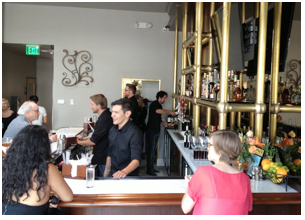MAKING POINTS-Two restaurants operate within a block of downtown Mar Vista, illuminating old and new Los Angeles in high relief.
Pepy’s Galley (photo above) has been in business for 40 years as the store-front, user-friendly face of a bowling alley, having assumed the business model and clientele of an even earlier incarnation of old-time SoCal.
It’s hugely-fenestrated space reveals booths filled steadily by diners consuming comfort food from AltaCalifornia of yore.
The drinking space next door is dank and dark and dim and even though cigarettes have been banned for years, this “cocktail lounge” impounds the slightly dangerous, musty vibe of an era since vaporized.
Down a perpendicular street is a New Folks’ eatery-and-bar, attracting, entertaining and retaining an utterly different crowd. Starting with the passive enticement, there is no family-friendly-but-slightly-mysterious duality of the huge plate-glass windows-cum windowless interior of Pepy’s. Louie’s of Mar Vista ( photo below) signals its status to local traffic by gratuitously oxidizing hydrocarbons using that very 20-teens-specific oddity known as a “bonfire gas heater”.
To reach a dining patio one passes through, rather than sits adjacent to, a private, dedicated bar room; the distinction between wine and dine sections is fluid.
While food is available as a meal only, the fare at Louie’s is not traditional comfort food but small plates of gourmanderie featuring mushrooms grown by a neighbor and bee hives on the roof, sourced “locally” as much as possible, and served with an implied paean to slow food and its attendant political agenda. Which is not to say this may not be tomorrow’s comfort food for today’s young, but that would be evolution, revealed.
In part because the plates are á la carte and small, they are a good value if not the outright bargain of Pepy’s, and pay succulent homage to a new sensibility of how food integrates with business, fraternity and society.
Meanwhile, Pepy’s provides support and companionship to its patrons from another era and class. Within walking distance of a large assisted-living population, and sporting as well a wide-open parking lot that accommodates an impressive variety of motorized vehicles, from campers to multi-ton emergency vehicles to trooper’s scooters, it is often faster to roust safety and emergency personnel from the dining room than wait for them on hold with 911-dispatch.
To the members of its tribe, Pepy’s patrons report those same parallel feelings of affirmation and acceptance from the long-term “substitute family” waitstaff as are enthusiastically shared among Louie’s decidedly younger, more lithe and expensive coterie.
 Like the lunchroom counter of long ago, a senior sitting at Pepy’s counter might find herself slipped an order of gratis French fries redolent with memories of a time when trans fats were the currency of youth. The incipient middle aged of today prefer a more diverse and savory mixture of exotic and combinatory flavors.
Like the lunchroom counter of long ago, a senior sitting at Pepy’s counter might find herself slipped an order of gratis French fries redolent with memories of a time when trans fats were the currency of youth. The incipient middle aged of today prefer a more diverse and savory mixture of exotic and combinatory flavors.
Where these communities clash is when they are reduced to market value only. In physical reality, each stays quite apart from the other with separate pools of cordial, if indifferent, direct relations. But when measured against each other in terms of earning power, the younger out-muscles the older; niceties of long-term community are secondary to market share.
But it is when an outside corporation buys the long-term icon of an old-time community, with little regard for the face of true community harboring any inherent value short of commodification or profit, that the stage is set for conflict and upheaval.
Because the new money adherents of our increasingly winner-take-all, middle-class-less society, do not themselves understand the callous disruption their society imposes. Displacement or cruelty is collateral, if unintentional and uncredited damage to a mentality of profit über-alles among these insulated, altered classes.
Today’s hipsters may revel in the world of service splayed before them but if consideration is not afforded those of past standing, they will find themselves soon-enough on the outside of a fickle society that changes with ever-increasing frequency.
There is a value and a virtue to be derived from respect for the different layers of our society. The prerogative of Business and its profit motive ought not to be the exclusive driving force of community development. While space and purpose yet remain for sectors of former or lesser preeminence, respect – and prudence — dictates that these be sustained. After all we, all of us, move up and out.
Permitting ourselves to be wrung for money just and only as long as we are trending upward along some earnings trajectory, simply mulches our community for that time increasingly near, when we will ourselves in turn be deemed expendable to market forces indifferent to any sense of Community.
It is strange to be living amongst a neighborhood on the verge of “flipping” between an old and new face of society. From the new cheese monger marketing $30-$70/lb wares to the long-gone phalanx of used furniture stores arrayed along Venice Boulevard distinguished chiefly by cigarette smoke wafting about its entrances, west LA’s business community is starting to reflect the magnitude of its resident’s mean real estate values.
To the extent this displacement disenfranchises some among us, the improvement remains ambiguous. Would that some political will were generated that could sustain coexistence.
(Sara Roos is a politically active resident of Mar Vista, a biostatistician, the parent of two teenaged LAUSD students and a CityWatch contributor, who blogs at redqueeninla.com)
-cw
CityWatch
Vol 12 Issue 52
Pub: June 27, 2014




